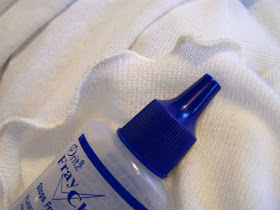As many of you know, I'm making an effort to sew through my fabric stash. We live in a small home with limited storage space. There is simply no sense in buying more fabric until I start using up what I have on hand. I've had some lovely sweater knit sitting in my fabric dresser, two pieces actually. One piece was some left over yardage from this ivory cowl tunic, and the other is some cute yellow and gray striped sweater knit. I ordered the yellow and gray fabric online. It looked adorable online, but somehow I missed that there were sparkles involved. So I had to change my plans for a cardigan. A simple sweater knit blanket seemed to be the perfect choice.
One of my favorite projects that I made for Miles has been my lightweight knit receiving blanket. It has a nice stretch, and it breathes really well. It's perfect for wrapping up a little babe. The lettuce leaf serged edges make for a cute decorative finish as well. I used the same technique with this sweater knit, and I love the results. So I thought I'd share the process with you.
First off you will want to cut your material into your chosen dimensions. I decided to make mine square. The yellow and gray material was cut into a 40" square, but the cream is about a 35" square, both sizes will work well as a receiving blanket. This step is a bit trickier than it sounds. Sweater knit sticks to itself a bit, getting the stripes to line up when I was cutting my favorite was a bit of a challenge.
Once you have a square cut, you will want to fold your fabric in half lengthwise, and then widthwise, matching up your corners. I chose to round off the edges of my material, it really makes serging easier.
To round off the edges of my blanket I used a plate as my guide. I lined it up so that the the curve of the plate met up with the edges of my cut.
Use a rotary cutter (or scissors) to trim around the plate.
Now it's time to serge the edges. You could pull out your serger manual, to find specific machine settings for a lettuce leaf edge, or a narrow rolled hem.
The settings that I used are for my brother 1034d, which is seems that many people have. My hem is not technically a rolled hem, but as you can see, my stitch width is set for a rolled hem, and my stitch finger is removed. My stitch length is set on about a 1, and my differential is at 1.0, and my knife is on.
As is quite apparent by the photo, I just adjusted my tension wheels until my stitching looked right. I used three threads for this stitch, with my needle in the right position. My tension wheels were all set somewhere between a four and a five. The main difference between this stitch and a narrow rolled hem, is that the lower looper tension is still about normal, it isn't rolling the fabric down toward the wrong side of the fabric.
I like to begin serging about 6 inches from the lower right corner. I trim off at least a quarter inch as I go, I find that doing so ensures that the raw edges are caught in the stitching. Work your way around the blanket until you get just about back to where you started.
 |
Note: this is not the right picture, I started out with my needle in the left position, but then re-serged the whole thing, so just pretend that it is a narrow hem.
|
When you get just about to your starting point, turn off your knife, and serge the remaining length of material, and about 1/2" past your starting point. Turning the knife off will prevent you from trimming off the previously serged edges.
In the picture above you can see the added bulk where the serging overlapped. Trim the chain off.
Use a bit of fray check or block to secure your serged edges.
The fun ruffled edges are created as the fabric stretches as it goes through the serger. I personally like the look. I added a little heart applique that was left over from my "I'll be in my study" sweater vest. (this after all of the heart drama with the car seat cover).
I plan on gifting both of these little blankets, but I'm tempted to make one for myself.
Tips and Tricks
Thread your needle with the new thread, and chain off. I would say that I have about a 75% success rate with this technique. Every once in a while my lower looper thread likes to throw a fit, and I end up rethreading anyway, but I'm more than happy when it works.
Thanks for reading!
















These look great! I'm also trying to sew through my stash and clean out things we don't need. Winter drives me crazy! I will keep your serger tip in mind if I ever get one.
ReplyDeleteAw, this looks so nice and comfy!!!!
ReplyDeletelove K